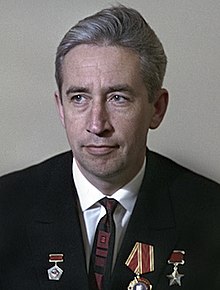
Extravehicular activity (EVA) is any activity done by an astronaut in outer space outside a spacecraft. In the absence of a breathable Earthlike atmosphere, the astronaut is completely reliant on a space suit for environmental support. EVA includes spacewalks and lunar or planetary surface exploration. In a stand-up EVA (SEVA), an astronaut stands through an open hatch but does not fully leave the spacecraft. EVAs have been conducted by the Soviet Union/Russia, the United States, Canada, the European Space Agency and China.
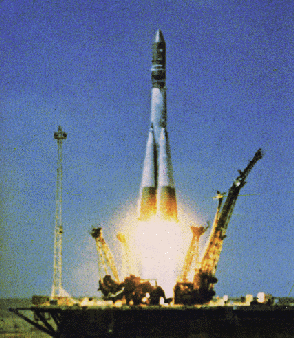
Vostok 1 was the first spaceflight of the Vostok programme and the first human orbital spaceflight in history. The Vostok 3KA space capsule was launched from Baikonur Cosmodrome on 12 April 1961, with Soviet cosmonaut Yuri Gagarin aboard, making him the first human to reach orbital velocity around the Earth and to complete a full orbit around the Earth.

The Soyuz programme is a human spaceflight programme initiated by the Soviet Union in the early 1960s. The Soyuz spacecraft was originally part of a Moon landing project intended to put a Soviet cosmonaut on the Moon. It was the third Soviet human spaceflight programme after the Vostok (1961–1963) and Voskhod (1964–1965) programmes.

Vladimir Mikhaylovich Komarov was a Soviet test pilot, aerospace engineer, and cosmonaut. In October 1964, he commanded Voskhod 1, the first spaceflight to carry more than one crew member. He became the first Soviet cosmonaut to fly in space twice when he was selected as the solo pilot of Soyuz 1, its first crewed test flight. A parachute failure caused his Soyuz capsule to crash into the ground after re-entry on 24 April 1967, making him the first human to die in a space flight.
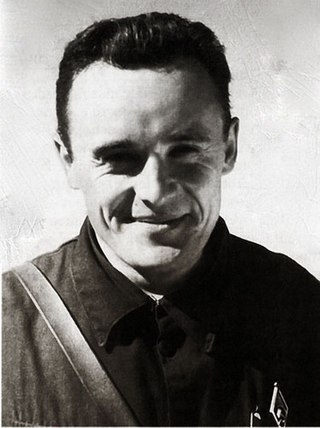
Sergei Pavlovich Korolev was the lead Soviet rocket engineer and spacecraft designer during the Space Race between the United States and the Soviet Union in the 1950s and 1960s. He invented the R-7 Rocket, Sputnik 1, and was involved in the launching of Laika, Sputnik 3, the first human-made object to make contact with another celestial body, Belka and Strelka, the first human being, Yuri Gagarin, into space, Voskhod 1, and the first person, Alexei Leonov, to conduct a spacewalk.

Vostok 2 was a Soviet space mission which carried cosmonaut Gherman Titov into orbit for a full day on August 6, 1961, to study the effects of a more prolonged period of weightlessness on the human body. Titov orbited the Earth over 17 times, exceeding the single orbit of Yuri Gagarin on Vostok 1 − as well as the suborbital spaceflights of American astronauts Alan Shepard and Gus Grissom aboard their respective Mercury-Redstone 3 and 4 missions. Titov's number of orbits and flight time would not be surpassed by an American astronaut until Gordon Cooper's Mercury-Atlas 9 spaceflight in May 1963.

Andriyan Grigoryevich Nikolayev was a Soviet cosmonaut. In 1962, aboard Vostok 3, he became the third Soviet cosmonaut to fly into space. Nikolayev was an ethnic Chuvash and because of it considered the first Turkic cosmonaut.

Vostok 6 was the first human spaceflight to carry a woman, cosmonaut Valentina Tereshkova, into space.
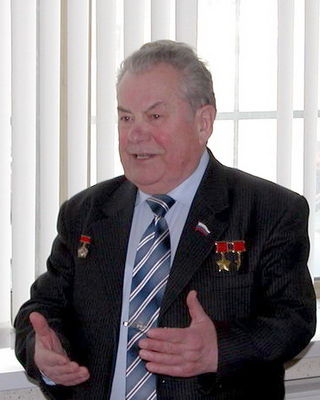
Pavel Romanovich Popovich was a Soviet cosmonaut.

Valery Fyodorovich Bykovsky was a Soviet cosmonaut who flew on three space flights: Vostok 5, Soyuz 22, and Soyuz 31. He was also backup for Vostok 3 and Soyuz 37.

Voskhod 1 was the seventh crewed Soviet space flight. Flown by cosmonauts Vladimir Komarov, Konstantin Feoktistov, and Boris Yegorov, it launched 12 October 1964, and returned on the 13th. Voskhod 1 was the first human spaceflight to carry more than one crewman into orbit, the first flight without the use of spacesuits, and the first to carry either an engineer or a physician into outer space. It also set a crewed spacecraft altitude record of 336 km (209 mi).

Voskhod 2 was a Soviet crewed space mission in March 1965. The Vostok-based Voskhod 3KD spacecraft with two crew members on board, Pavel Belyayev and Alexei Leonov, was equipped with an inflatable airlock. It established another milestone in space exploration when Alexei Leonov became the first person to leave the spacecraft in a specialised spacesuit to conduct a 12-minute spacewalk.

Pavel Ivanovich Belyayev was a Soviet fighter pilot with extensive experience in piloting different types of aircraft. He was the first commander of the cosmonaut corps and the cosmonaut who commanded the historic Voskhod 2 mission which saw the first man walk in space in 1965.

Georgy Timofeyevich Beregovoy was a Soviet cosmonaut who commanded the space mission Soyuz 3 in 1968. From 1972 to 1987, he headed the Yuri Gagarin Cosmonaut Training Center.

Valery Nikolaevich Kubasov was a Soviet/Russian cosmonaut who flew on two missions in the Soyuz programme as a flight engineer: Soyuz 6 and Soyuz 19, and commanded Soyuz 36 in the Intercosmos programme. On 21 July 1975, the Soyuz 7K-TM module used for ASTP landed in Kazakhstan at 5:51 p.m. and Kubasov was the first to exit the craft. Kubasov performed the first welding experiments in space, along with Georgy Shonin.

The Vostok programme was a Soviet human spaceflight project to put the first Soviet cosmonauts into low Earth orbit and return them safely. Competing with the United States Project Mercury, it succeeded in placing the first human into space, Yuri Gagarin, in a single orbit in Vostok 1 on April 12, 1961. The Vostok capsule was developed from the Zenit spy satellite project, and its launch vehicle was adapted from the existing R-7 Semyorka intercontinental ballistic missile (ICBM) design. The name "Vostok" was treated as classified information until Gagarin's flight was first publicly disclosed to the world press.
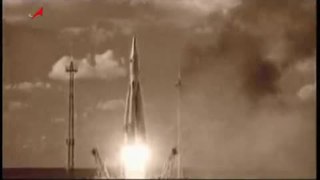
The Soviet space program was the state space program of the Soviet Union, active from 1951 until the dissolution of the Soviet Union in 1991. Contrary to its American, European, and Chinese competitors, which had their programs run under single coordinating agencies, the Soviet space program was divided between several internally competing design bureaus led by Korolev, Kerimov, Keldysh, Yangel, Glushko, Chelomey, Makeyev, Chertok and Reshetnev. Several of these bureaus were subordinated to the Ministry of General Machine-Building. The Soviet space program served as an important marker of claims by the Soviet Union to its superpower status.
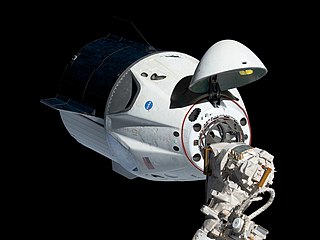
A space capsule is a spacecraft designed to transport cargo, scientific experiments, and/or astronauts to and from space. Capsules are distinguished from other spacecraft by the ability to survive reentry and return a payload to the Earth's surface from orbit or sub-orbit, and are distinguished from other types of recoverable spacecraft by their blunt shape, not having wings and often containing little fuel other than what is necessary for a safe return. Capsule-based crewed spacecraft such as Soyuz or Orion are often supported by a service or adapter module, and sometimes augmented with an extra module for extended space operations. Capsules make up the majority of crewed spacecraft designs, although one crewed spaceplane, the Space Shuttle, has flown in orbit.

Vostok 3 and Vostok 4 were Soviet space program flights in August 1962, intended to determine the ability of the human body to function in conditions of weightlessness, test the ground control capability to launch and manage two separate, concurrent flights, and test the endurance of the Vostok 3KA spacecraft over longer flights. Cosmonaut Andriyan Nikolayev orbited the Earth 64 times in Vostok 3 over nearly four days in space, August 11–15, 1962, a feat which would not be matched by NASA until the Gemini program (1965–1966). Pavel Popovich was launched on Vostok 4 on August 12, and made 48 Earth orbits. The two capsules were launched on trajectories that brought the spacecraft within approximately 6.5 km (4.0 mi) of each another.
